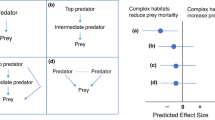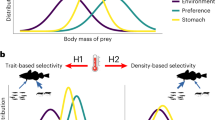Abstract
STUDIES of the effects of predators on prey diversity have usually focused on patterns of predation that do not by themselves increase diversity. For example, size-selective fish decrease diversity by driving large bodied zooplankton to local extinction1. Size-selective predators can maintain a diversity of species only if large bodied prey hold some advantage over smaller prey, such as the difference in feeding efficiency hypothesised by Brooks and Dodson (ref. 1 and see ref. 2 for review). The diversifying effect of nonselective predation on competitors for space in the rocky intertidal zone3 depends on the presence of differences among competitors in time of settlement during the year. In contrast, selective removal of common prey tends to reverse any numerical advantage gained by one species over another. Thus it is of interest to see whether numerically selective predators increase diversity by equalising prey numbers. The results presented here show that general predators in fact repeatedly equalise the relative abundance of prey species and hence tend to stabilise prey communities.
This is a preview of subscription content, access via your institution
Access options
Subscribe to this journal
Receive 51 print issues and online access
$199.00 per year
only $3.90 per issue
Buy this article
- Purchase on Springer Link
- Instant access to full article PDF
Prices may be subject to local taxes which are calculated during checkout
Similar content being viewed by others
References
Brooks, J. L. & Dodson, S. I. Science 150, 28 (1965).
Hall, D. J., Threlkeld, S. T., Burns, C. W. & Crowley, P. H. A. Rev. Ecol. Syst. 7, 177 (1976).
Paine, R. T. Am. Nat. 100, 65 (1966).
Baker, M. C. Ecology 55, 162 (1975).
Goss-Custard, J. C. J. Anim. Ecol. 46, 21 (1977).
Griffiths, D. Ecology 56, 1209 (1975).
Iwanowicz, H. R., Anderson, R. W. & Ketschke, B. A. Monograph 17 Massachusetts Department of Natural Resources (1974).
McCracken, F. D. J. Fish Res. Bd Can. 20, 551 (1963).
Peilou, E. C. An Introduction to Mathematical Ecology (Wiley, New York, 1969).
Sokal, R. R. & Rohlf, F. J. Biometry (Freeman, San Francisco, 1969).
Author information
Authors and Affiliations
Rights and permissions
About this article
Cite this article
SCHNEIDER, D. Equalisation of prey numbers by migratory shorebirds. Nature 271, 353–354 (1978). https://doi.org/10.1038/271353a0
Received:
Accepted:
Published:
Issue Date:
DOI: https://doi.org/10.1038/271353a0
This article is cited by
-
Microlandscape Experiments: Are They Useful for Scale, Scaling, and Cross-Scale Inference?
Current Landscape Ecology Reports (2022)
-
Changes in the spatial distribution of subtidal macrobenthos due to predation by white shrimp (Litopenaeus setiferus)
Estuaries and Coasts (2007)
-
Predation regulation of sedimentary faunal structure: potential effects of a fishery-induced switch in predators in a Newfoundland sub-Arctic fjord
Oecologia (2005)
-
Patchy distributions: Optimising sample size
Environmental Monitoring and Assessment (1993)
-
Estimate of removal rate ofNereis virens (Polychaeta: Nereidae) from an intertidal mudflat by gulls (Larus spp.)
Marine Biology (1986)
Comments
By submitting a comment you agree to abide by our Terms and Community Guidelines. If you find something abusive or that does not comply with our terms or guidelines please flag it as inappropriate.



